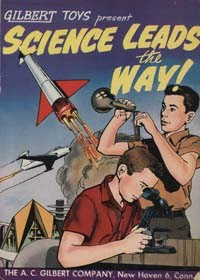AC Gilbert Co - My Home Lab

Do you remember experimenting in your back yard? Maybe you owned a chemistry set like me. AC Gilbert and Co. began their wonderful product in 1909, in Westville, Conn. It survived many years, as an excellent educational tool. As a child of the 50s I enjoyed owning a set that opened with two panels. The manual and test tubes took up most of one side and the chemicals the other. It also had an alcohol lamp with an attached blowtorch. When you wanted to melt a glass rod, you had to blow into a black tube. I wonder if any kid ever sucked in by mistake. We very seldom followed instructions. Let's just mix some stuff together and see what we get. I wonder how many of you had the same experience. Let me know what kinds of experiments you conducted.


Comments
I spent many enjoyable hours with it, and supplemented it with supplies from a company named, "Perfect" lab supplies. I also had my father's college level general chemistry book, and whatever my city library and family owned drugstore could provide. My friends and I were fascinated with learning. Our favorite TV shows were "Mr. Wizard", and the "Bell Labs Science Series", along with "Man and the Challenge," and Disney "World of Tomorrow" presentations. By the time I was in college, there were students protesting outside the chemistry and physics building. Love Canal, Lake Erie, Napalm, Agent Orange, Silent Spring, DDT. It was the beginning of the new dark ages, where we are still deeply entrenched. Fear, greed, political expediency, superstition, poor journalism, misinformation, trial lawyers, and ignorance. I wonder how all the wrong principles have taken control. There is a business now, that goes around to middle schools, and high schools. It "educates" the board and administration on the dangers of having scientific reagents in the school labs. Then it charges a handsome fee to clean out and dispose of the laboratory chemicals. The chemicals are not needed "they" say, because any chemistry experiment can be simulated on a computer screen. No wonder we are falling behind China and India, where "real" chemicals are not illegal. Our politicians, and the para-military enforcement groups they empower (like the DEA) have made it all but impossible, not to mention hideously expensive, to experiment in chemistry. There is another business on-line named "United Nuclear" that still attempts to sell small quantities of "dangerous" chemical reagents to the public. Lazar the owner, was met with a guns loaded and drawn, para-military swat team of government agents one morning who arrested him on trumped up charges of violating postal regulations. In reality, they just wanted to shut him down (for any reason). If you sold a useful chemistry set now, the government and/or the trial lawyer would bankrupt you, or incarcerate you.
It is the new dark ages.
Robert Littlejohn
A measure is about 20 ml. or if you took a 1/4th teaspoon measuring utensil (you can purchase at Walmart) it would take about 16 measures to fill it up. Using this as your guide, you could probably make you a little measuring spoon by trial and error.
Here are the measurements of my orginal spoon. It is 1/4 in. dia., by 1/8th in. deep, keep in mind that the depth means the deepest part of the spoon.
Another thought for you, I don't believe the experiments in those old chemistry sets required extremely accurate amounts. Accuracy usually falls under quantitative analysis, which is beyond the scope of the toy sets. Instead of using a kg scale or a graduated cylinder, they used spoon measures and test tube estimates. The chances are that any error in measures would only settle to the bottom of the test tube. You should still get your results in terms of color change or precipitates. However, if you were doing a magic trick it could ruin your effect. For example, if you were simulating the change of water to wine using Phenolphthalein with a base and then turning it clear using an acid, it might require more accurate measurements. I remember having problems with this one, because the red liquid tended be become cloudy, not clear.
As for the possible errors, I would first look at the age of the chemical. Most of my old sets aren't able to work correctly, because my chemicals are over 40 years old.
If you are using new chemicals then make sure its grade is correct. I believe the old sets used technical grade.
Thanks for the post.
If this info was helpful, consider linking to me if you have a website.